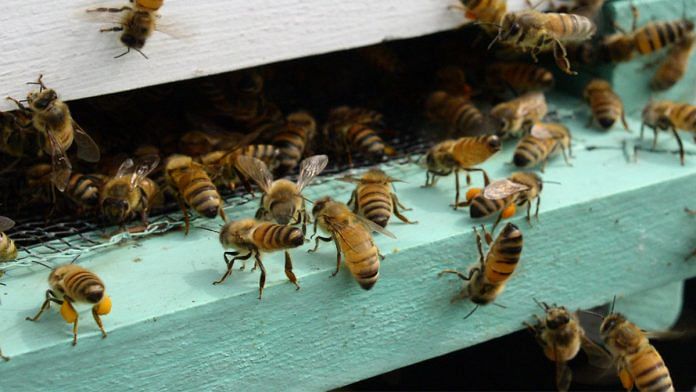New Delhi: A study of three different honeybees species in India has revealed that the insects’ waggle dance have different ‘dialects’ based on the distance they travel for food — solving a 70-year-old zoological mystery.
The waggle dance of honeybees is a unique form of communication, which occurs during foraging. When a bee discovers a food source, it returns to the hive and communicates its location to the other bees with a dance describing the direction and distance.
Part of the dance is the ‘waggle run’, in which the bees energetically shake their abdomen. The direction of the waggle run communicates the direction of the destination in relation to the sun, while the duration of the wagging indicates the distance.
The fact that honey bees may have different dance ‘dialects’ was first proposed in the 1940s by Nobel-winning ethologist Karl von Frisch and his student Martin Lindauer. However, the existence of such dialects could not be established through subsequent experiments. The new research, published in the journal Proceedings of the Royal Society B Wednesday, proves this theory to be true.
Also read: We just taught bees a simple number language – and they got it
Different duration of waggle for different species
The study, conducted by research teams from the National Centre for Biological Sciences (NCBS) in Bangalore and Julius-Maximilians-Universität Würzburg (JMU) in Germany, shows that the development of these dialects is related to the radius of action within which they collect food around the hive.
“As the distance of the food source from the nest increases, the duration of the wagging increases in a linear fashion,” said Patrick Kohl, a PhD student at JMU in a statement.
However, the increase is different for different species. To prove this, the researchers carried out experiments with three honeybee species in South India with different radii of action.
The eastern honeybees (Apis cerana) fly up to one kilometre away from the nest, the dwarf honeybees (Apis florea) fly up to 2.5 kilometres and the giant honeybees (Apis dorsata) about three kilometres.
The study shows that the opposite relationships apply for the increase in the duration of the waggle.
For example, if a food source is 800 metres away, an eastern honey bee will have a much longer wagging than a dwarf honeybee, who will have a longer wagging than the giant honeybee.
In order to communicate an identical distance to the food, each species uses its own dance pattern.
“India has the advantage that three honeybee species live in the same area so that their dance dialects could be easily compared,” said Kohl.
The results also confirm what von Frisch and Lindauer had suspected about the meaning of the dance dialects that honeybees evolve these dialects in relation to the distance they travel. If they have to communicate a very long distance, they develop different patterns to convey it to the hive.
The global decline in the population of honeybees has been a cause of serious concern as these pollinators are crucial to human well-being and livelihoods. Understanding their behaviour may play an important role in the conservation of the species that is intricately linked to the planets’ future food security.
Also read: The honeybee is cute, charismatic, and misunderstood



